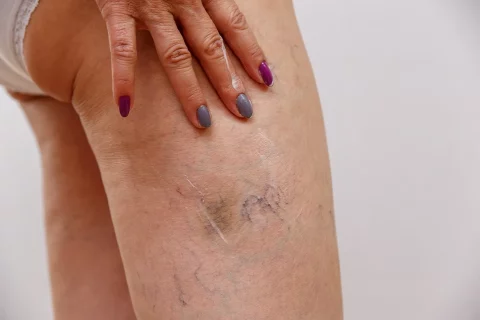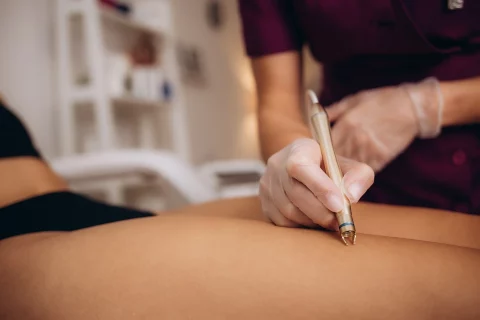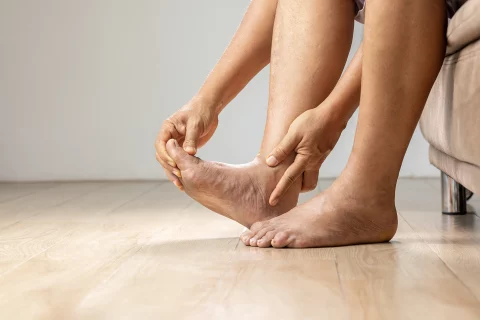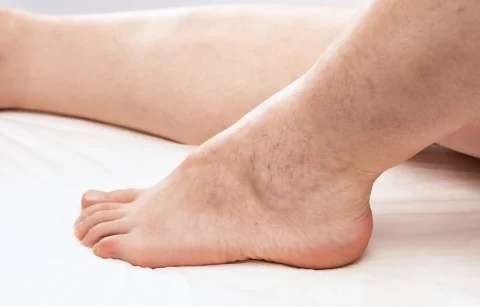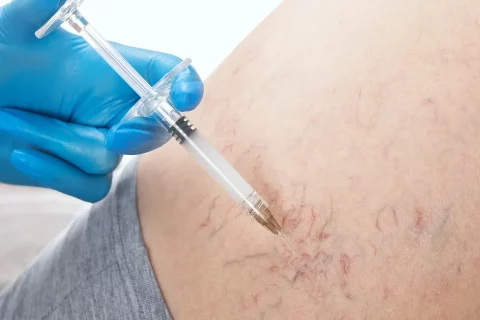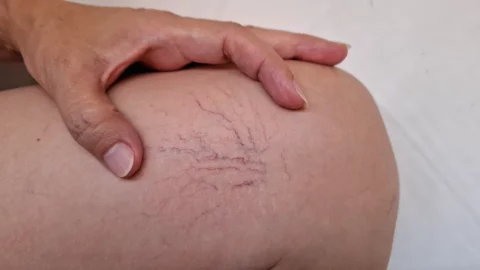Spider veins on the legs, face, and other parts of the body are common for many adults. Treatments like IPL therapy and radiofrequency procedures are often performed to safely eliminate these unsightly veins so that patients won’t have to go through the pain and long downtime of vein stripping.
So what’s the difference between IPL therapy and radiofrequency treatment for spider veins? Although they’re both used for safely eliminating the unsightly veins from beneath the skin surface, these treatments use different energy-based devices and technologies to do so. IPL therapy uses a light-based device while radiofrequency treatments utilize an electricity-based instrument to heat and close the damaged veins.
Learn More: How Soon Can I See Results from Spider Veins Laser Treatment?
IPL Therapy vs. Radio Frequency Therapy: Are They Different?
Spider veins are a type of venous condition that affects about 30% to 60% of adults. These clusters of blue, purple, or red veins appear just beneath the surface of the skin when the valves inside the blood vessels become faulty. It causes the damaged veins to enlarge and become visible on the skin’s surface.
If you’re concerned about the appearance of spider veins and the associated symptoms, there are safe and effective treatments like IPL therapy and radiofrequency therapy to get rid of them. IPL therapy uses light energy with different wavelengths to target and seal the damaged blood vessels. On the other hand, RF therapy uses radiofrequency waves to heat the scar tissue so that it closes and absorbs the damaged vein.
Both energy-based treatments are excellent in restoring healthy, vein-free skin. They’re also cheaper, safer, and less painful than surgical procedures like vein stripping. However, patients might find that one of the non-surgical vein treatment options works better for them than the other.
Consulting with a vein specialist like the experts at Vein Center Doctor helps patients understand each treatment they go through better. This helps them create better decisions about their health and appearance.
Everything You Need to Know About IPL Therapy
IPL therapy is similar to laser therapy in that it uses light energy to eliminate the unwanted veins on the skin. What many patients love about this light treatment is that it doesn’t involve incisions, needles, or a sclerosing agent to get rid of spider veins.
How it Works
Intense pulsed light (IPL) treatments utilize a broad spectrum of different light wavelengths to selectively target and damage the broken blood vessels near the surface of the skin. During the treatment, the doctor uses a special device that heats the lining of the blood vessel wall. The treated spider veins eventually fade and get absorbed by the body a few weeks after the treatment.
The light energy from the IPL reaches into the deeper layers of the skin without damaging the outermost layers of the skin and the surrounding tissues. Patients might experience minor discomfort during the procedure, but the pain is tolerable for most of them.
Ideal Candidates
IPL therapy is proven safe and effective, especially for patients who have good overall health and want to get rid of their abnormal veins without plastic surgery. However, patients with darker skin tone are more likely to experience side effects like skin discoloration after their IPL procedure.
People shouldn’t have this treatment if they:
- Take blood-thinning medicines like aspirin
- Are pregnant or nursing
- Have skin that easily develops sunburn
- Take prescription isotretinoin (Accutane)
The best way to find out if a patient is an ideal candidate for IPL therapy is to consult a trusted provider. During the initial consultation, the doctor examines the patient’s condition and reviews their medical history. This is to see if there are risk factors that might affect the treatment or the patient’s recovery.
Results
Each treatment session takes about 20 to 45 minutes depending on the treatment area. Some patients may see immediate improvements on their skin if they only have small clusters of broken blood vessels. Those dealing with larger veins like reticular varicose veins might need multiple treatment sessions to completely have their veins removed.
Since IPL therapy doesn’t require a lot of downtime, most patients usually return to their normal activities almost immediately after the treatment. There might be some bruising or redness in the treated areas, but they eventually fade after a few days. If the area feels warm after the procedure, just apply an ice pack over it to help soothe the pain or discomfort.
The treated spider veins are permanently gone after the IPL therapy. However, new spider veins might still develop even in the treated areas, which is why it’s important to take care of the skin and body to prevent more visible veins from forming.
Possible Side Effects
Although IPL therapy is a mild, non-surgical procedure, it’s still associated with certain risks and minor side effects like:
- Pain
- Redness
- Blistering
- Temporary Skin Discoloration
- Skin burns
Most of these side effects subside a few days after the treatment but call a medical professional immediately if they worsen or persist. It’s also important to find a board-certified dermatologist or laser technician to perform the procedure to achieve optimal results and minimize the risk of developing procedural complications.
Read More: What’s the Easiest Way to Get Rid of Spider Veins on the Face?
Everything You Need to Know About Radio Frequency Therapy

Radiofrequency ablation is another minimally invasive procedure that eliminates the unsightly spider veins on the skin. But instead of using light energy to close the damaged vein, doctors use radiofrequency (RF energy) to heat the blood vessel from the inside.
How It Works
Endovenous radiofrequency ablation treatment works by heating the lining of the affected vein to stimulate the formation of scar tissue. The scar tissue then closes the damaged vein and the blood flows to the other nearby healthy veins.
During the radiofrequency treatment, the doctor maps out the damaged veins first using ultrasound. They also inject local anesthesia to the treatment area to minimize the pain during the procedure.
The doctor then creates a small incision on the skin where a tiny tube called a catheter is inserted. A radiofrequency fiber is placed inside the catheter. This small fiber delivers thermal energy to close the faulty vein.
Once the treatment is done, the doctor removes the catheter and applies pressure to the insertion area to prevent bleeding. They may also put bandages or compression stockings on the legs.
Ideal Candidates
Like IPL treatment, radiofrequency ablation is also a safe treatment that works well for healthy patients with spider veins and varicose veins. The treatment is also great for people of all skin types and tones since the radiofrequency technology is “colorblind.”
When consulting a medical professional about the treatment, patients should let them know about their medical history and any kind of prescription or over-the-counter medications they’re taking. These might affect the treatment and recovery, which is why it’s extremely important to give your provider full disclosure.
Results
The entire radiofrequency ablation procedure takes about 1 to 3 hours, including prep time. Since the procedure is only minimally invasive, patients don’t have to worry about taking a few days off work for their recovery. Most of them even resume their normal activities on the same day as the treatment.
Patients also said that their legs feel a lot lighter immediately after the treatment. The spider veins take a few days or weeks to fade as they slowly shrink and get absorbed by the body. Doctors also recommend using compression stockings for at least one week to speed up the recovery process. Follow-up treatments are also scheduled to ensure that the veins are properly closed.
Possible Side Effects
Since radiofrequency ablation treatment is a non-surgical alternative to vein ligation and stripping, serious complications and side effects are extremely rare. However, patients might still experience minor side effects like:
- Blood clotting
- Pain
- Bruising
- Skin burns
- Scarring
- Skin discoloration
These symptoms eventually subside after a few days or weeks but contact a healthcare professional immediately if they worsen or persist.
Choosing The Best Spider Vein Removal Treatment
Both IPL therapy and radiofrequency treatments are great options for eliminating the noticeable veins without surgery. Consulting with a trusted vein specialist helps patients find out which treatment works best for their condition, budget, and most especially, expected results.
If you’re deciding which between IPL therapy and radiofrequency ablation is better for you, here are some of their benefits and disadvantages to help you decide:
| Pros | Cons | |
| IPL Therapy | This is much safer than other types of laser treatments because it doesn’t damage the surrounding skin and tissue. | Patients with lighter skin tone experience better results than those with darker complexions. This treatment works for patients with dark skin too, but they’re more likely to experience skin discoloration than others. |
| Radiofrequency Ablation | Even patients with darker skin tones may benefit from this treatment because radiofrequency is “colorblind.” | There’s a risk of scarring because the doctor needs to create a tiny incision on the skin to insert the catheter and radiofrequency fiber. Finding a skilled vein surgeon to perform the treatment helps minimize this risk. |
Get Rid of Spider Veins Without Surgery at Vein Center Doctor

At Vein Center Doctor, we have a team of highly- trained and highly-skilled vein experts who perform non-surgical treatments for spider veins, varicose veins, and other venous conditions.We offer a wide range of treatment options including compression therapy, EVLT, RFA, sclerotherapy, and VenaSeal to treat your damaged veins and relieve uncomfortable symptoms like pain and swelling in the legs.
All of our treatments are performed inside state-of-the-art facilities using the latest vein removal technology to ensure the patient’s safety and comfort at all times. Book your vein removal treatment with us today and call us at 1-862-227-1054.


